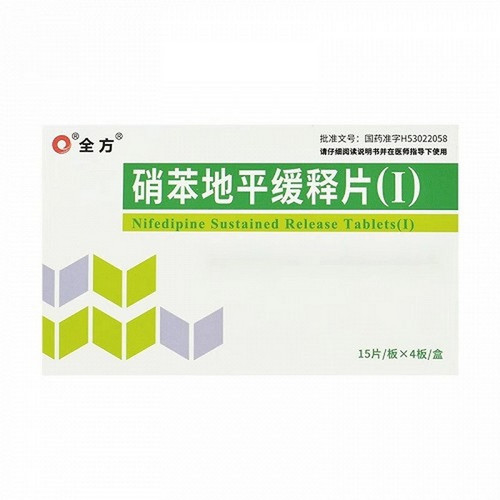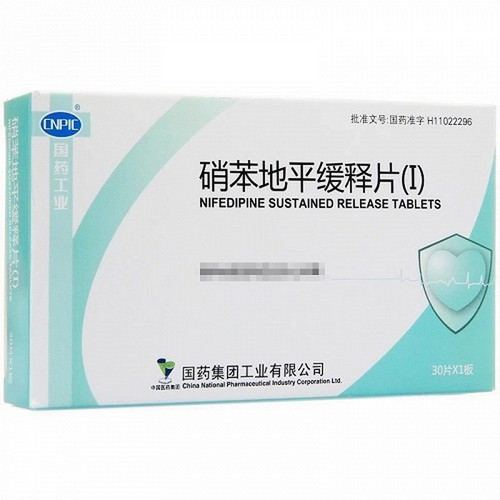Product Overview
[Drug Name]
Generic Name: Nifedipine Sustained-Release Tablets(I)
Trade Name: Hengxin Nifedipine Sustained-Release Tablets(I) (10mg x 60 tablets)
Pinyin Code: HengXin XiaoBenDiPingHuanShiPian(I)
[Main Ingredients]
The active ingredient of this product is nifedipine. Chemical Name: 2,6-Dimethyl-4-(2-nitrophenyl)-1,4-dihydro-3,5-pyridinedicarboxylate. Molecular Formula: C₁ₐH₁₈N₂O₆. Molecular Weight: 346.34
[Indications/Main Functions]
Various types of hypertension and angina pectoris.
[Specifications]
10mg x 60 tablets
[Dosage and Administration]
Oral: 10-20mg (1-2 tablets) twice daily. Maximum dose: 40mg (4 tablets) per dose, 0.12g (12 tablets) per day.
[Adverse Reactions]
1. Liver: Occasionally, jaundice and elevated glutamate oxaloacetate aminotransferase and glutamate oxaloacetate aminotransferase levels may occur. 2. Circulatory System: Occasionally, chest pain, headache, flushing, dizziness, palpitations, decreased blood pressure, and lower limb edema may occur. 3. Allergies: Occasionally, allergic symptoms such as hives and itching may occur. 4. Digestive System: Occasionally, abdominal pain, nausea, loss of appetite, and constipation may occur. 5. Oral: Gingival hypertrophy may occur. 6. Metabolic Abnormalities: Occasionally, hyperglycemia may occur.
[Contraindications]
Cardiogenic shock, acute myocardial infarction (within 80 days).
[Drug Interactions]
1. Combination with nitrates to control angina attacks and is well tolerated. 2. Combination with beta-blockers: This product is well tolerated and effective in most patients, but may induce and aggravate hypotension, heart failure, and angina in some patients. 3. Concomitant use with digitalis may increase blood digoxin concentrations. Therefore, digoxin blood concentrations should be monitored during initial use, dose adjustments, or discontinuation of this drug. 4. Concomitant use with highly protein-bound drugs, such as dicoumarols, phenytoin, quinidine, quinine, and warfarin, often alters the free concentrations of these drugs. 5. Concomitant use with cimetidine may increase peak plasma concentrations of this drug; therefore, dose adjustments should be made accordingly. 6. The Cmax and AUC of this drug may be increased when grapefruit juice is taken with this drug.
[Precautions]
1. When discontinuing calcium channel blockers, the dose should be gradually reduced. Do not discontinue medication without a doctor's advice. 2. Use with caution in patients with hypotension. 3. Use with caution in patients with severe aortic valve stenosis or hepatic or renal impairment.
[Pediatric Use]
Safety and efficacy are not yet established.
[Use in Elderly Patients]
This drug has a prolonged half-life and increases Cmax and AUC. It is important to start with the lowest dose to reduce the incidence of adverse reactions.
[Overdose]
Insufficient research data are available. Existing literature suggests that increasing the dose can cause excessive peripheral vasodilation, leading to or exacerbating hypotension. Patients experiencing clinical hypotension due to drug overdose should receive prompt cardiovascular support, including cardiopulmonary monitoring, leg elevation, and monitoring of circulating blood volume and urine output. Vasoconstrictors (norepinephrine) can be used to restore vascular tone and blood pressure, unless contraindicated. Patients with impaired liver function have prolonged drug clearance. Hemodialysis cannot eliminate nifedipine.
[Pharmacology and Toxicology]
This drug is a calcium influx blocker or slow-channel blocker that blocks calcium ions from entering cells through channels on the myocardial or vascular smooth muscle membrane. This reduces vascular tone and dilates systemic vessels, including the coronary arteries, thereby lowering blood pressure and increasing coronary artery blood supply. On the other hand, it can inhibit myocardial contraction, reduce myocardial work, reduce oxygen demand, and relieve angina pectoris. When used in therapeutic doses, it has little effect on the function of the sinoatrial and atrioventricular nodes.








